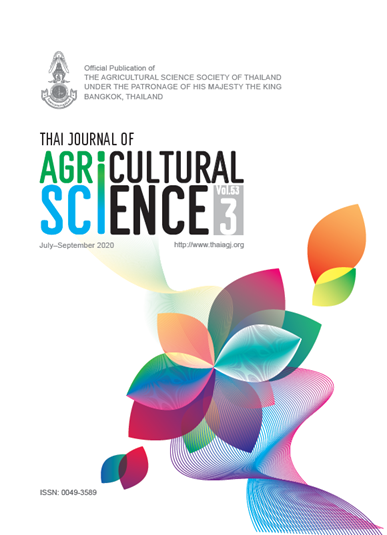Yield performance of early-maturity cowpea (Vigna unguiculata) elite lines under four varied environments
Main Article Content
Abstract
Cowpea (Vigna unguiculata) is a leguminous crop that can widely adapt to diverse environments, including high temperature and drought–prone areas. Due to its early maturity, the cowpea has been introduced into cropping systems. Cowpeas are utilized as fresh pod, dry grain, fodder and green manure. The cowpea breeding project herein developed cowpea lines through crossing and pure line selection, in which 27 lines were selected. However, performance evaluation is most required prior to their release to the farmer. A total of 29 cowpea lines (27 lines from a breeding program and 2 of check varieties) were evaluated under four environments at the Department of Agronomy, Faculty of Agriculture, Khon Kaen University from 2016 to 2018. The trials were laid out in a randomized complete block design with three replications. The results found the significance of G × E interaction on grain yield. A planting date of November 15, 2017 presented the greatest grain yield (286.6 g/m2). The higher temperature of April 9, 2017 affected the shortening days to flowering (32.10 days) and days to harvest (50.23 days). According to regression and GGE biplot, CPL33, 305, 39D, and KKM60–2 are great in yield performance and adaptability across four environments. Moreover, they are also early maturity (68–72 days) and suitable for crop rotation.
Article Details
References
Becker, H.C. and J. Leon. 1988. Stability analysis in plant breeding. Plant Breed. 101: 1–23. Cruz, C.D. and A.J. Regazzi. 1994. Biometrical Model Applied to Genetic Improvement. Imprensa Universitaria, Vicosa, Brazil.
Eberhart, S.A. and W. Russell. 1966. Stability parameters for comparing varieties. Crop Sci. 6: 36–40.
El-Shaieny, A.A.H., Y.Y. Abdel-Ati, A.M. El-Damarany and A.M. Rashwan. 2015. Stability analysis of components characters in cowpea (Vigna unguiculata (L.) Walp). J. Hortic. For. 7: 24–35.
FAO (Food and Agricultural Organizations of the United Nations). 2018. FAOSTAT. Available Source: www.fao.org/faostat/en/#data. July 19, 2020.
Francis, C.A. 1981. Development of plant genotypes for multiple cropping systems. In: K.J. Frey, (Ed.), Plant Breeding II. Iowa State University Press, Iowa, USA.
Giami, S.Y. 2005. Influence of cowpea (Vigna unguiculata L. Walp) variety on protein quality and sensory properties of akara, a popular West African cowpea–based food. J. Sci. Food Agric. 85: 261–264.
Gollob, H.F. 1968. A statistical model which combines features of factor analytic and analysis of variance techniques. Psychometrika 33: 73–114.
Gomez, A.K. and A.A. Gomez. 1984. Statistical Producers for Agricultural Research. 2nd Edition. John Wiley & Sons Inc., New York, USA.
Hall, A.E. 2012. Phenotyping cowpeas for adaptation to drought. Front. Physio. 3: 155.
Huehn, M. 1990. Nonparametric measures of phenotypic stability. Part 1: Theory. Euphytica 47: 189–194.
IBPGR (International Board for Plant Genetic Resources). 1983. Descriptors for Cowpea. IBPGR Secretariat. Rome, Italy.
Kamdi, R.E. 2001. Relative stability, performance and superiority of crop genotypes across environments. J. Agric. Biol. Environ. Stat. 6: 449–460.
Mortimore, M.J., B.B. Singh, F. Harris and S.F. Balde. 1997. Cowpea in traditional cropping systems, pp. 99–113. In: B.B. Singh, (Ed.), Advances in Cowpea Research. International Institute of Tropical Agriculture, Ibadan, Nigeria.
Onofri, A. and E. Ciricifolo. 2007. Using R to Perform the AMMI Analysis on Agriculture Variety Trials. The Newsletter of the R Project for Statistical Computing.
Osho, S.M. and K. Dashiell. 1997. Expanding Soybean Production, Processing and Utilization in Africa. GTZ. Post–Harvest Systems. The Newsletter for Post–harvest Systems Development in Africa No. 1. In: C. Gomez. 2004. Cowpea Post–harvest Operation. AGST/FAO, Rome, Italy.
R Development Core Team. 2012. R: A Language and Environment for Statistical Computing. R Foundation for Statistical Computing, Vienna, Austria. Available Source: www.R-project.org/.
Rocha, M.M., K.J. Damasceno-Silva, J.A.N. de Menezes-Júnior, H.W.L. de Carvalho, A.F. da Costa, J.M.P. de Lima, J.F. dos Santos, C.H.C.M. Bertini, A.R. Passos and O.M. Morais. 2017. Yield adaptability and stability of semi-prostrate cowpea genotypes in the Northeast region of Brazil by REML/BLUP. Rev. Ciênc. Agron. 48(5): 879–888.
Simmonds, N.W. 1991. Selection for local adaptation in a plant breeding programme. Theor. Appl. Genet. 82: 363–367.
Singh, B.B. 1994. Breeding suitable cowpea varieties for West and Central African savanna, pp. 77– 85. In: J.M. Menyonga, J.B. Bezuneh, J.Y. Yayock and I. Soumana, (Eds.), Progress in Food Grains Research and Production in Semiarid Africa. OAU/STRCSAFGRAD. Ouagadougou, Burkina Faso.
Singh, B.B., J.D. Ehlers, B. Sharma and F.R. Freire Filho. 2002. Recent progress in cowpea breeding, pp. 22–40. In: C.A. Fatokun, S.S. Tarawali, B.B. Singh, P.M. Kormawa and M. Tamò, (Eds.), Challenges and Opportunities for Enhancing Sustainable Cowpea Production. International Institute of Tropical Agriculture, Ibadan, Nigeria
Steele, W.M. and K.L. Mehra. 2009. Structure, evolution and adaptation to farming systems and environments in Vigna, pp. 393–404. In: R.J. Summerfield and A.H. Bunting, (Eds.), Advances in Legume Science. Royal Botanic Gardens, Kew, UK.
Tarawali, S.A., B.B. Singh, M. Peter and S.F. Blade. 1997. Cowpea haulm as fodder, pp. 313–325. In: B.B. Singh, D.R. Mohan Raj, K.E. Dashiell and L.E.N. Jackai, (Eds.), Advances in Cowpea Research. International Institute of Tropical Agriculture (IITA) and Japan International Research Center for Agriculture Sciences (JIRCAS). IITA, Ibadan, Nigeria.
Willey, R.W. 1979. Intercropping, its importance, and research needs. Part 1. Competition and yield advantages. Field Crop Abstracts 32: 1–10.


